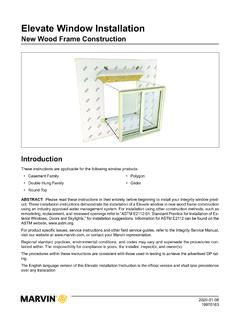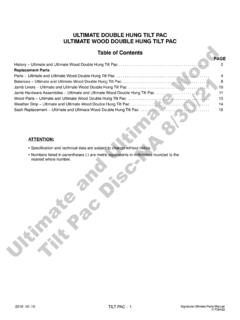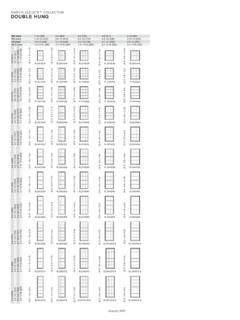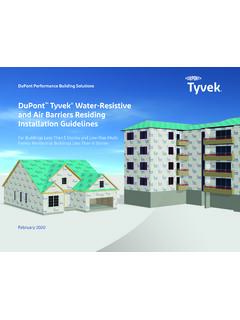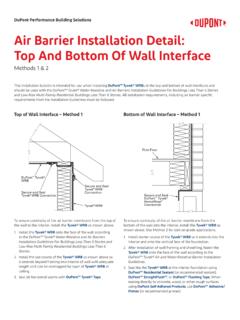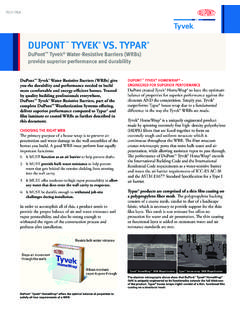Transcription of Window Rough Opening Prep and Flashing - Marvin
1 Window Rough Opening Prep and Flashing Method A1-Membrane Drainage System ABSTRACT: Please read these instructions in their entirety before beginning to install your Marvin , Integrity, or In- finity Window product. These installation instructions demonstrate the proper Rough Opening preparation (RO prep). in new wood frame construction using an industry approved water management system. For RO prep and installa- tion using other construction methods, such as remodeling, replacement, and recessed openings refer to "ASTM. E2112, Standard Practice for Installation of Exterior Windows, Doors, and Skylights. for suggestions. Information for ASTM E2112 can be found on the ASTM website, Method A1 applies to non-integral flanged and wood windows. Weather Resistive Barrier (WRB) is to be applied prior to Window installation.
2 Head jamb Flashing will be applied over the face of the non-integral mounting flange. The sill pan flash detailed within is a TYPE III (flex- ible membrane). 2019-05-13. 19913776. Table of Contents Note to Installer .. 3. Cutting the Weather Resistive Barrier (WRB) and Pan Flashing .. 4. Flashing the Installation .. 6. Insulating and Sealing the Installation-Nailing Fin .. 9. Insulating and Sealing the Installation-Casing .. 10. Exterior Sealing Procedures ..11. 2019-05-13 2 Window Rough Opening Prep and Flashing 19913776 Method A1-Membrane Drainage System Note to Installer Consideration of the Window installation and wall as a system is important. The recommended method in AT T E N T I O N. these instructions and referenced elsewhere are intend- Plan your Rough Opening carefully.
3 The use of pannings ed to do just that. These details follow the concept that will affect the Rough Opening height clearance. stopping air flow into the RO cavity will aid in managing water intrusion. Striving to form a continuous air barrier, water drainage plane, an insulation barrier, and a con- tinuous vapor barrier is best practice; matching the win- I M P O R TA N T. dow installation to the design of the actual wall system. Regional standard practices, environmental conditions, These details show a TYPE III flash pan (flexible mem- and codes may vary and supersede the procedures brane) and were based on ASTM E2112. This is one contained within. The responsibility for compliance is way to prep and flash a sill. Your situation may be differ- yours: the installer, inspector, and owner(s).
4 Ent from those shown here. In that case we recommend that you reference other details found in ASTM E2112. WA RNING! Other types of panning are: TYPE I: Rigid sheet, 1 piece or multiple pieces Always practice safety! Wear the appropriate eye, ear TYPE II: Rigid sheet, multiple pieces and hand protection, especially when working with pow- TYPE IV: Combination rigid flexible membrane er tools. (multiple pieces). Supplies Needed Safety glasses Flashing materials Level Weather resistive barrier (WRB). Hammer Hearing protection Insulation Square Perimeter sealant Sill pan flash Plastic or composite shims Tape measure Backing material (foam backign rod). Materials Used The following materials were used to develop these in- NOTE: Foam should be minimal expanding, low com- structions.
5 Other materials may be used but must be pression, closed cell foam and compliant with ASTM. compatible with one another. Refer to each product's E2112, sec. technical specification for compatibility and usage: Sealant: OSI Quad Pro-Series ; solvent release Weather Resistant Barriers (WRB): dupont butyl rubber sealant or DAP DynaFlex230 . tyvek homewrap NOTE: Sealant must be compliant with ASTM C920. Panning Material: dupont FlexWrap NF . Grade NS Class 25. Flashing Materials: dupont Flashing Tape (butyl). Other Materials: dupont Seam Seal Tape . Insulation: Dow GreatStuff Pro foam beveled siding product, and various fasteners insulation, loose fill fiberglass insulation. noted within. 2019-05-13 3 Window Rough Opening Prep and Flashing 19913776 Method A1-Membrane Drainage System Cutting the Weather Resistive Barrier (WRB) and Pan Flashing NOTE: This does not apply to self-adhering WRB.
6 Sheathing systems. 1. Make horizontal cuts to the Weather Resistive Barrier (WRB) across the top and bottom of the Rough Opening . Make a vertical cut down the center of the RO. then make 45 degree cuts away from the corners of the top of the RO. See Figure 1. Figure 2. 3. Flip the top up and side flaps away and tack temporarily. See Figure 3. Figure 1. 2. Trim up from the bottom corners about 2" (51) and then make an additional horizontal cut about 3 1/2" (89). wide. See Figure 2. Figure 3. 4. Optional: Add a continuous "Sill Wedge" out of cedar siding or similar water resistant material to create a positive drainage slope. Glue it to the RO sill with two beads of adhesive and screw in place. See Figure 4. 2019-05-13 4 Window Rough Opening Prep and Flashing 19913776 Method A1-Membrane Drainage System 6.
7 Wrap side flaps to the interior and staple in place about 1 1/2" (38) from the interior edge of the Opening . Cut the excess off near the staple so that a 1" -1 1/2". (25-38) strip of bare wood is exposed. Tape this edge with seam seal tape. See Figure 6. Figure 4. NOTE: This will affect your RO height, plan according- ly. 5. TYPE III Sill Pan Flash: Apply self sealing flexible membrane slope. See Figure 5. Figure 6. 7. Apply seam seal tape over the corners. Place plastic or composite shims at the ends and in the middle of the RO to counter the slope of the sill wedge and support the unit. Fasten with adhesive or finish nails. If using finish nails, place adhesive under shim where the nail will penetrate. See Figure 7. Figure 5. 1 Flexible Flashing membrane NOTE: Some situations call for an upturned leg at the interior.
8 If that is the case, do so using the excess sill Flashing membrane to the interior. Figure 7. 2019-05-13 5 Window Rough Opening Prep and Flashing 19913776 Method A1-Membrane Drainage System Flashing the Installation 4. Install a rigid head flash. Seal both horizontal and I M P O R TA N T vertical legs of the rigid head flash. See Figure 10. Nailing fin is not designed to be a weatherproof Flashing . I M P O R TA N T. Follow the Flashing tape manufacturer's recommended instructions for attaching to the building materials under the WRB. For example, priming wet or frozen wood, ap- plication temperature, etc. 1. On units that use nailing fin, apply nailing fin corner gaskets. Follow the instructions on the back of the gasket. See Figure 8. Figure 10. 1 Rigid head flash 2 Sealant 5.
9 Optional Skirt: Install an optional "skirt" in applications with exposure to wind driven rain/climate. Use Flashing material or a 12" (305) strip of WRB and attach to the sill of the Window with seam seal tape or Flashing tape. See Figure 11. Figure 8. 2. If using the factory applied vinyl drip cap, make sure it extends about 1/8" (3) beyond the edge of the Window on each side. 3. Apply a bead of sealant beneath the vinyl drip cap along the top of the head jamb as shown in Figure 9. Figure 11. 1 Skirt (WRB material or other). 2 Adhesive tape 3 Attached to sill of Window 6. Lap vertical strips of adhesive Flashing tape onto the Figure 9. unit and out over the WRB. Make small diagonal cuts at 1 Vinyl drip cap the head jamb as in Figure 12 to allow the membrane to 2 Sealant fold back onto the exterior and frame.
10 2019-05-13 6 Window Rough Opening Prep and Flashing 19913776 Method A1-Membrane Drainage System NOTE: This does not apply to self adhered WRB. Figure 12. 7. Install another layer of adhesive membrane lapping onto the head jamb of the unit and over the sheathing. The membrane Flashing at the head jamb should extend and cover the Flashing previously installed at the jambs. Make relief cuts and fold down so that it wraps around the jamb See Figure 13 and Figure 14. Figure 15. 9. Seal the ends of the rigid head flash by injecting sealant at each end. See Figure 16. Figure 13. Figure 16. 10. Seal the ends of the vinyl drip cap or rigid head flash, by injecting sealant at each end. See Figure 17. Figure 14. 8. Tape the top edge of the head jamb Flashing with seam seal tape. See Figure 15.
